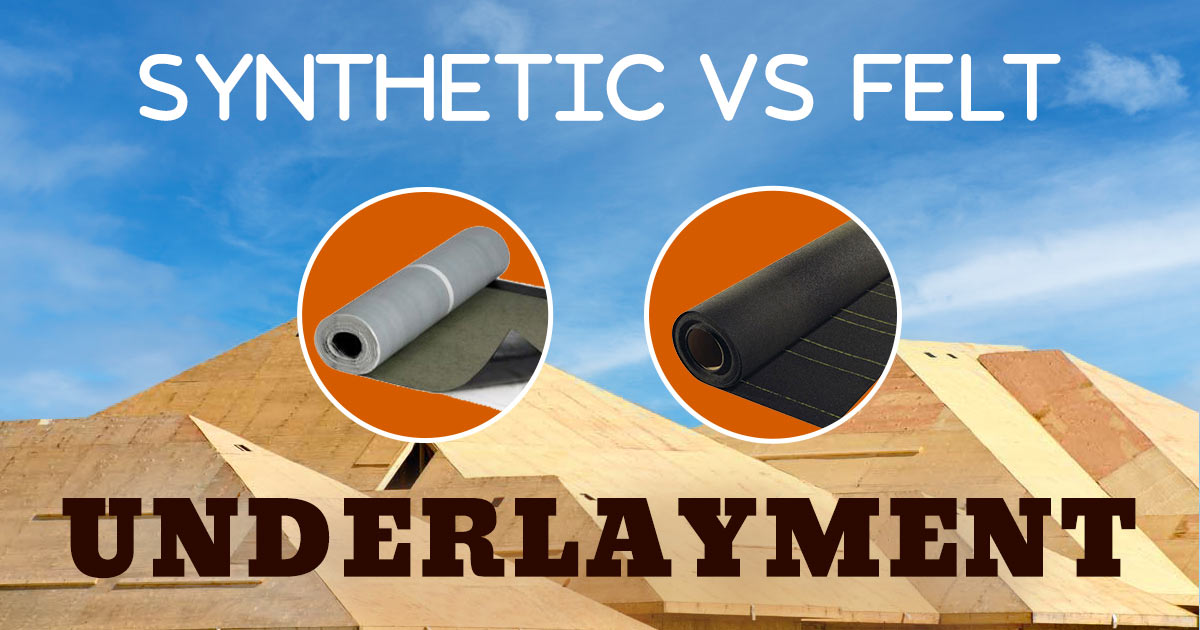Synthetic vs. Felt Underlaymen
What Homeowners Should Know
Published: 12/09/2021

When establishing the fundamentals for your new rooftop, the importance of selecting the right roofing underlayment can’t be ignored. Your choice can heavily impact the performance of your roof, its endurance, and whether or not your roof meets building code requirements.
To help you ensure that you achieve a successful installation, we’ll go over what underlayment is, and how the two main types (synthetic and felt) differ. By the end of this quick rundown, you should have a better idea of what your roof needs and how to proceed.
What is Underlayment?
Roofing underlayment is the protective layer that is laid over the sheathing/decking and beneath the shingles. It is meant to function as a weatherproof barrier to keep moisture from penetrating into the roof sheathing and the interior structure beneath it.
This can prevent serious problems from developing, such as mold, rot, electrical hazards, property damage, and other types of water damage. Underlayment can also contribute to a roof’s fire resistance.
Synthetic
Synthetic underlayments are composed of laminated polypropylene or polyethylene plastic. They are comparable in consistency to housewrap. One significant difference, however, is that basic synthetic underlayments also serve as vapor barriers. This makes them unsuitable for rooftops that have no ventilation. Vapor-permeable synthetics are available, but they are notably more expensive than standard synthetics (i.e. 20-90¢ per sq. ft. vs 11-15¢ per sq. ft.).
Advantages of synthetic underlayments include superior UV resistance and a lighter weight. They do not offer sufficient protection for spots that are vulnerable to ice dams, but here in South Florida, that isn’t a big worry.
Additionally, synthetic underlayments offer extra durability in the form of traction and tear resistance. This makes them ideal for installation on roofing projects that may not be completed for an extended period of time. The synthetic covering will adequately protect the roof structure until the shingles are finally installed. Such strength and weather resistance is especially a perk in our region, where we regularly have to worry about roofing damage due to hurricane-force winds.
A critical point with synthetic underlayment is that Florida’s building code imposes specific stipulations for what types suffice and how they are supposed to be installed. The latest code update calls for two layers of reinforced synthetic underlayment certified to comply with ASTM D226 Type II standards.
Pros
- More lightweight than felt
- Easy and quick insulation
- Resistant to weather and foot-traction
Cons
- More expensive than felt
- Bound to specific code requirements
- No vapor permeability except in more expensive products
Felt
Felt underlayments are a composite of recycled corrugated paper and sawdust, with asphalt infused into the felt for waterproofing purposes. Asphalt felt is the traditional choice for underlayments. The building code requires a #30 grade asphalt felt underlayment, with the exception of a few alternatives that are specified for their ability to provide equivalent protection.
Asphalt felt is the most economical option available, costing at least 50% less than synthetic underlayments. It isn’t as hardy as synthetic underlayment, meaning one can’t count on it offering adequate protection if left exposed. This is why it is advised that felt underlayments only be used on roofing projects that can be completed the same day, or at least shielded from the elements by a temporary covering system.
The vapor-permeability of asphalt felt makes it a better choice for attics that have little to no ventilation, or may have pockets that are vulnerable to moisture collection. Vapor-permeable synthetics are an option in these cases, but they are quite a bit more expensive.
Pros
- More affordable than synthetic
- Vapor-permeable
- Readily accepted by building codes
Cons
- Tears easily underfoot or in high winds
- Wrinkles, cracks, and splits in exposure to cold and moisture
- Heavier and less material per roll than synthetic
Get the Best to Build Your Roof
Whether you’re already clear on what underlayment is best for your roof, or you feel like you need some guidance, we’re ready to help you ensure your project is successful.
AKVM has been helping homeowners throughout Bradenton and Sarasota install tough, durable rooftops. We’ll help you structure a roof that has the right composition at every level, deployed with expert technique and insight.
To get your FREE contactless inspection and estimate, please get in touch. Call (941) 727-3996
REQUEST A
FREE ESTIMATE

See What Our Customers Are Saying
Recent Posts
Choosing A Multi-residential Roofer
Choosing The Best Roofer
Energy Efficient Roofing Solutions
How Long Does It Take To Replace A Roof?
Debunking 10 Common Roofing Myths
2025 Roofing Tech & Trends
How To Choose Color For Tile Roof
What Is Drip Edge?
What Do Roof Vents & Penetrations Do?
How Roofs Impact Market Value
Best Roof for Florida
Maximizing Energy Efficiency
Roof Inspections 2024
Prepare Your Roof For Spring
Lifespan of Different Roofing Materials
How Roof Type Affects Value
Choosing Materials for Extreme Weather
Guide to Cleaning Gutters Safely
Emergency Roof Repair: What to do until the professionals arrive
New Roof Tech: GAF Solar Energy Shingles
How to Minimize Fire Hazards on Roof
How Florida Heat Affects Roof
Top Benefits of Shingle Roofs
Solar Options for Florida Homes
What to do if Hurricane Damages Roof
2023 Hurricane Season Roof Preparation Checklist
Does Adding Solar Increase Your Home's Value?
What it takes to be a GAF Master Elite Contractor
How To Choose The Right Roof Shingles
How To Choose The Right Windows & Doors For Your Home
How To Choose Solar Energy System For Your Home
What To Do If Tree Falls On Your Roof
Residential Roof Spring Cleaning Checklist
Should You Replace Your Gutters When You Replace Your Roof?
New Homeowners' Guide To Roof
Roof Warranties
2023 Solar Energy Trends
Time To Replace Front Door
Roofs With Curb Appeal
Roof is Leaking During Storm
New Roof vs. Repair